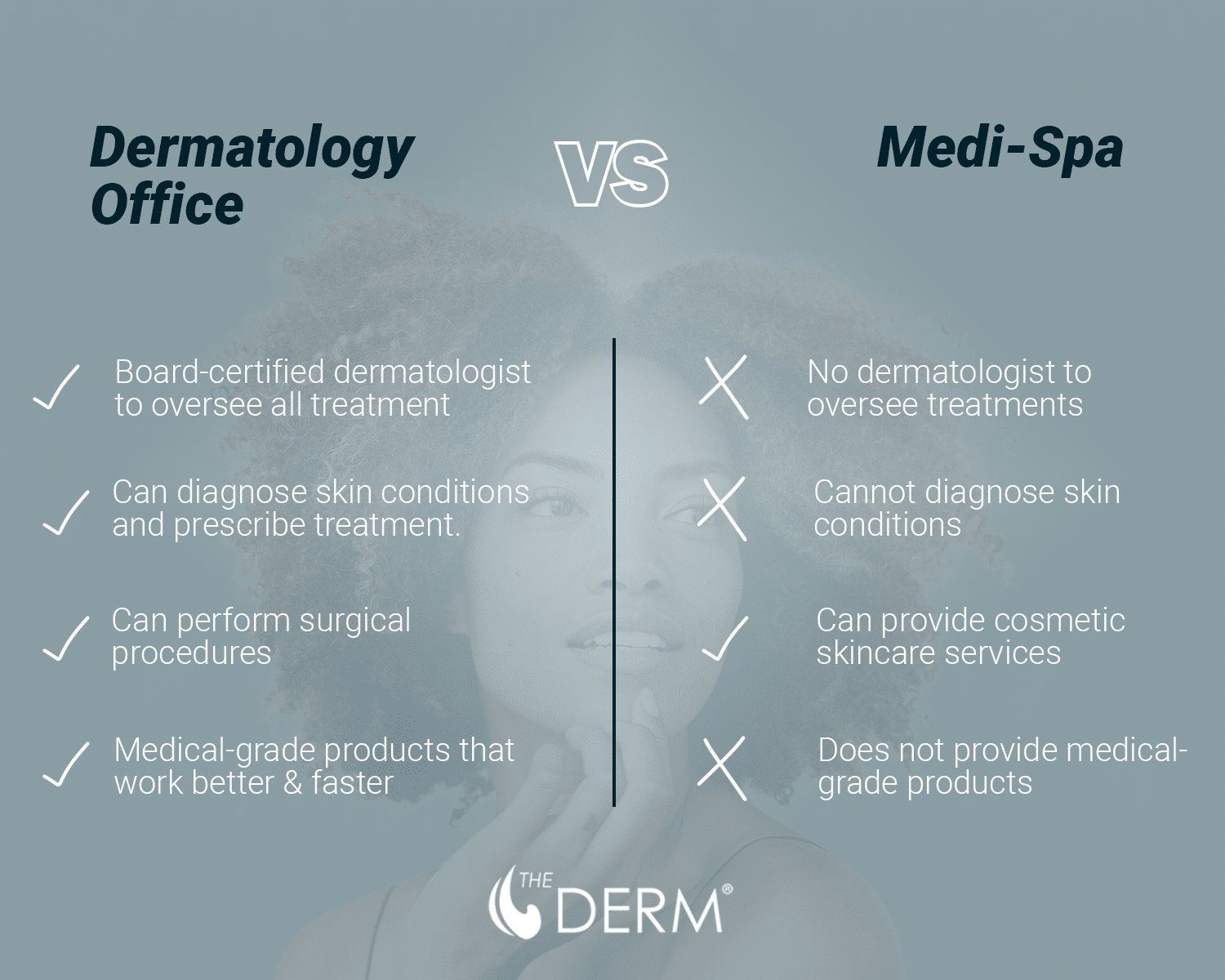When it comes to cosmetic treatments for your skin, there are more options available now than ever before. Often it comes to deciding between a medi-spa or a dermatologist office.
But what are the main differences?
Are all treatments created equal no matter where you go?
Let’s learn what your best options are for high-quality skincare, that is safe and effective.
What’s the difference between a dermatologist’s office and a medi-spa?
An important question you’re likely asking is the difference between a medi-spa and a dermatology office.
When you’re researching cosmetic dermatology treatments, an array of options are likely at your fingertips—literally, hundreds of results pop up on Google right away. But knowing which to book an appointment with can be confusing.
Do you go with a medi-spa or a dermatologist office boasting the same offers?
Here’s the main difference between the two:
Dermatology Office
A dermatologist office has a board-certified dermatologist overseeing every treatment, diagnosis, and regimen you’ll encounter. They have specific, advanced schooling, training, certifications and experience that allow for a comprehensive approach to skincare and accounting for any potential issues.
Dermatology offices can also diagnose skin conditions, provide skin cancer screenings, and they have a better understanding of more issues within skincare.
Medi-Spa
A medi-spa, or medical spa, can provide the same types of treatments as a dermatologist office. However, there is not a board-certified, trained dermatologist on site to oversee the treatment. This can open the door to incorrect treatments or a regimen that’s not quite tailored to your skin holistically.
Medi-spas cannot diagnose skin conditions, but rather they provide services to offer relief of minor ailments.

Is a medi-spa or dermatologist better?
While they both offer similar treatments when it comes to cosmetic services, a dermatology office is almost always the better option.
Why?
Because when you have a certified dermatologist overseeing treatments, the approach to solving your problem is holistic, and is more likely to result in lasting, high-quality results.
Not only that, but when you see a dermatologist, even for a minor skin concern like acne scarring, they may be able to diagnose underlying conditions resulting in acne scarring, as well as prescribing treatment options to help in the long-term.
Lastly, safety is a concern. While cosmetic dermatology is largely considered safe, there are still risks, some severe. This can include temporary or permanent nerve injury, discoloration of skin, unnatural or deformed-looking results, and more. Dermatologists are trained to avoid these mistakes, and also trained on how to respond quickly and effectively in the rare case that something should go wrong.
Treatments at a dermatologist vs medi-spa
We’ve already established the main differences between dermatology offices vs medi-spas, including that medi-spas are primarily for cosmetic services, but let’s take a look at the specific services for each.
Dermatology Offices:
- Skin cancer screenings
- Skin condition diagnosis
- Surgical dermatology
- Diagnosis and treatment of skin, hair, nails, veins, and more
- Cosmetic dermatology services
- Botox
- Chemical peels
- Fillers
- Laser Hair Removal
- Lasers for skin rejuvenation
- Microdermabrasion
- Photofacials
- Body contouring and toning
- Full body skin exams
- Hair loss diagnosis and treatment
- Pediatric dermatology
Medi-Spas:
- Cosmetic treatments
- Facials
- Chemical peels
- Microdermabrasion
- Fillers
- Laser hair removal
- Spider vein treatment
- Tattoo removal
In fact, even the skincare products you can purchase at a dermatology office will be more effective. That’s because medical-grade products, which have a higher concentration of the active ingredients (i.e. the ingredients that make the products work!) can only be distributed at a doctor’s office.
We always recommend that you first see a board-certified dermatologist to understand your skin, your options, and the best approach for you.







